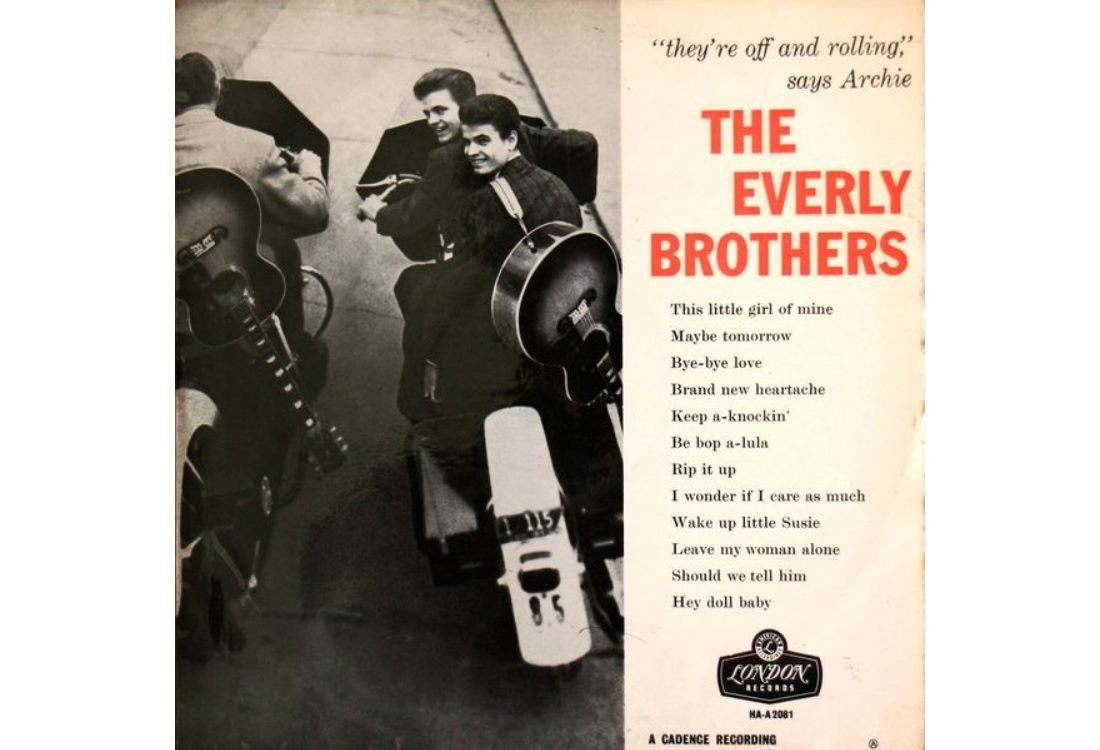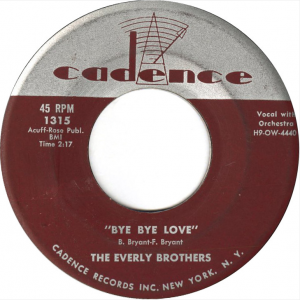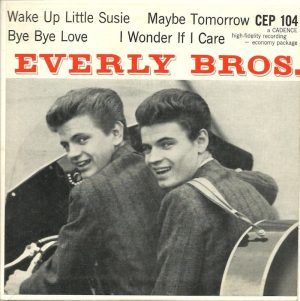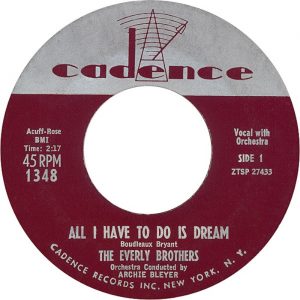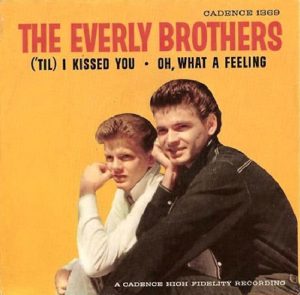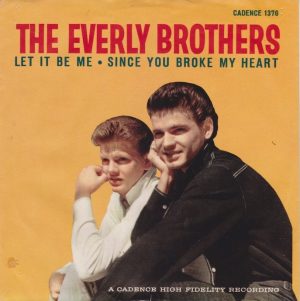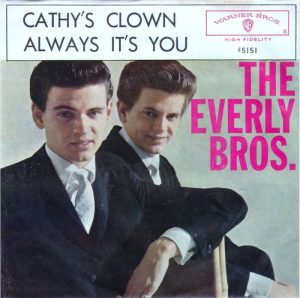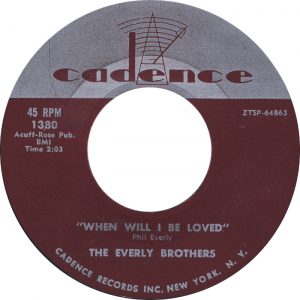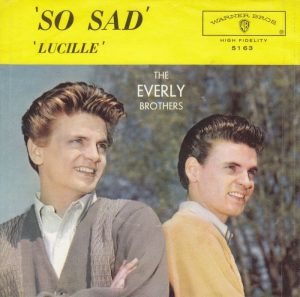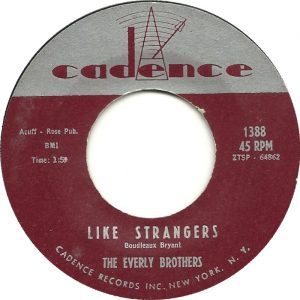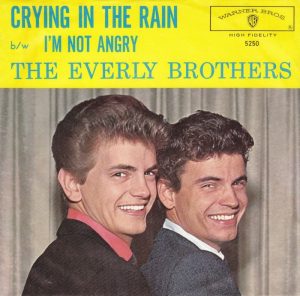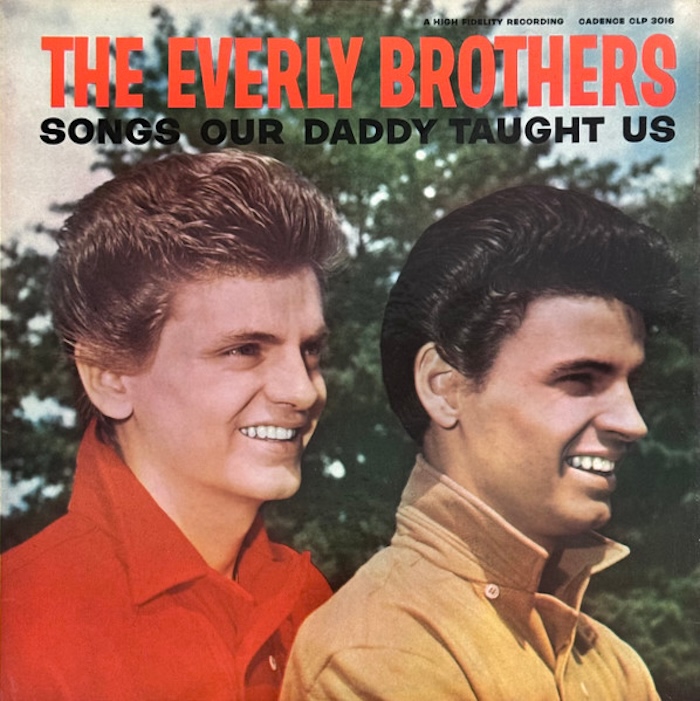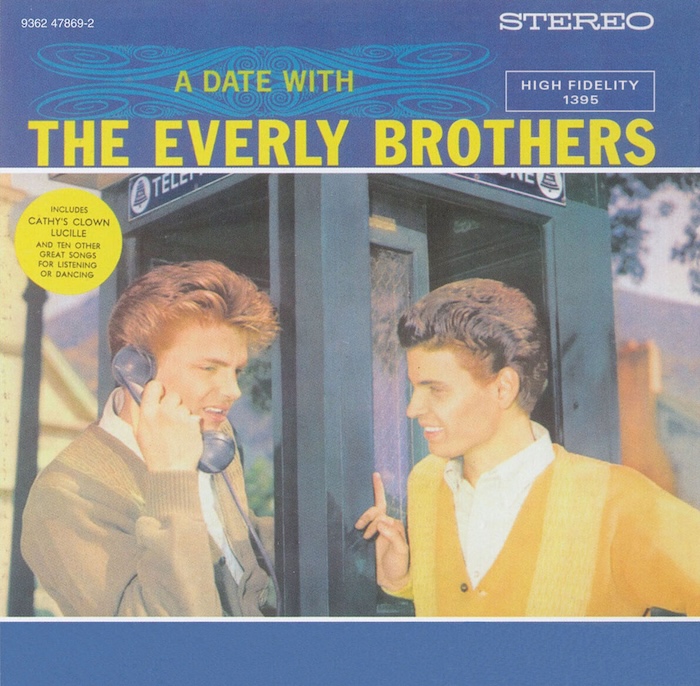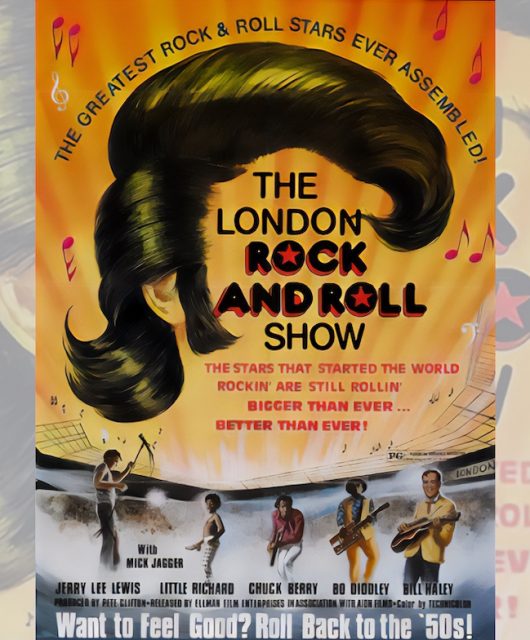In our lowdown on The Everly Brothers, we look at how the flowing harmonies and beautiful melodies of this sibling acoustic duo from Kentucky offered an alternative to the rebel rock of their peers that proved just as influential.
There were many early rock’n’rollers whose records teenagers would have hidden from their parents. It’s doubtful that anyone ever had cause to hide an Everly Brothers record, not even the mildly suggestive Wake Up Little Susie. Don and Phil Everly were very different propositions to the likes of Elvis Presley, Gene Vincent and Little Richard. Although some pundits detected a lean and hungry look in their eyes, their image was that of two clean-cut, all-American boys.
Their controlled harmonies and understated musicianship offered an alternative to the rowdy, rebellious hedonism of their peers. They projected emotional sensitivity and tenderness. Their lyrics had an air of teenage innocence and the longing for romantic security. White-picket-fence America had nothing to fear as they waxed some of the most beautiful rock’n’roll love ballads of all time.
But despite their unthreatening nature, there was nothing bland about The Everly Brothers, which meant they also won the approval of hardcore rock’n’roll audiences. Their respect for musical melody and the achingly heartfelt emotional clout of their vocal performances also made them acceptable to a wider catchment of popular music lovers.
Perfect Harmony
Their appeal to musicians ran deep. Don, the older brother (1937-2021), his voice slightly deeper and throatier, was usually to the fore, taking most of the solo vocal parts, while Phil (1939-2014) sang the high tenor harmony. They inspired a host of British beat groups and exponents of the California rock sound. Simon & Garfunkel adored them and Linda Ronstadt took a belting revival of When Will I Be Loved to No.2 in the US Hot 100 in 1975, 15 years after the brothers’ original had made No.8.
The placing of Don’s acoustic guitar up front in the mixing of their records was another key differential in their sound. It pointed to their roots. Their father Ike was a Kentucky country guitarist whose bluesy style was popularised by Merle Travis. Accomplished Appalachian-style guitarists in their own right, their close-harmony singing perpetuated a long tradition of brother duos in country music, which drew its power from their similar vocal timbres, phrasing patterns and shared cultural origins.
Pitch Perfect
Popular examples included The Blue Sky Boys, The Monroe Brothers, The Delmore Brothers, The Louvin Brothers and The Wilburn Brothers. But none of these had the youthful, photogenic marketability and range of The Everly Brothers.
Their most creative periods were for two labels. First, the spartan purity of their recordings for Archie Bleyer’s Cadence from 1957 to 1960, which marked the height of their teen appeal, and then at Warner Brothers, where a more polished sound brought initial success but ultimately diminishing returns. Despite solo endeavours and an acrimonious split in 1973, as a reunion concert at the Royal Albert Hall in 1983 showed, they were never better than as a duo.
KEY SONGS
Bye Bye Love
From their first session for Cadence, this propelled the boys towards the big time. It also started a fruitful association with the songwriters Felice and Boudleaux Bryant. The song had already done the rounds in Nashville, but Don and Phil, desperate to get started, needed the money. With the earnest, youthful quality of their singing, along with Don’s aggressively strummed acoustic guitar, it now sounds custom made for them.
Wake Up Little Susie
Of their Bryant-penned songs, only All I Have To Do Is Dream was a bigger hit than this teenage playlet, reaching No.1 in the US in and No.2 in the UK in 1957. The story of a young couple who fall asleep at a drive-in movie that “wasn’t so hot” and worry what to tell their parents and friends, “when they say ‘ooh-la-la!’” it seems a tame enough ditty today, but fell foul of some radio stations. No one else was remotely offended.
All I Have To Do Is Dream
The Everlys’ uptempo numbers are entertaining, but their ballads are timeless. All I Have To Do Is Dream was the first of the great ones. Paired with the snappy Roy Orbison-penned rocker Claudette to comprise what was surely one of their strongest ever singles, the double-sider, as well as being another stateside chart-topper, gave them the first of four UK No.1s in the spring of 1958.
(’Til) I Kissed You
Although the Bryants wrote 12 of the duo’s hits, Don was also an accomplished songwriter. Long before their Cadence period, he’d written Thou Shalt Not Steal, which Kitty Wells took into the Country Top 20. Sonny Curtis on guitar and drummer Jerry Allison of The Crickets played on the 1959 session that yielded this, the latter supplying a rarely heard tom-tom effect. Don also wrote the flipside, the soulful Oh What A Feeling.
Let It Be Me
Something of an outlier among the Cadence-era hits, this ballad was written by Frenchman Pierre Delanoë and first recorded by his compatriot Gilbert Bécaud in 1955 as Je t’appartiens. Jill Corey had done a translated version in 1957. But Don came to the song via Chet Atkins’ instrumental version. Forsaking their usual Nashville stomping grounds for New York’s Bell Sound Studios in December 1959, the brothers created another magical waxing.
Cathy’s Clown
In 1960 Don and Phil signed with Warner Brothers. While the loss of the intimacy and innocence of the Cadence era was regrettable, Cathy’s Clownwas a winner. The brothers’ harmonies on a killer chorus were supported by Buddy Harman’s striding drum beat. Primarily written by Don, with input from Phil, the B-side featured the heart-stoppingly lovely Always It’s You. A US No.1, it topped the British charts for eight weeks.
When Will I Be Loved
Despite the duo’s departure, Cadence continued releasing older material, so When Will I Be Loved, emerging after Cathy’s Clown, sounded like a reversion to the earlier sound. Still, with its yearning refrain, it became a signature number. The arrangement showed how much their recordings gained from Nashville’s finest sidemen. It’s since been much covered by artists seeking to revive the mood of a lost era of pop.
Lucille
The brothers had recorded Little Richard songs while at Cadence, but their recording of Lucille for Warner Brothers had a very different feel. As well as an extended electric guitar intro, it featured eight session guitarists playing that same riff in unison. This fresh sound enabled them to score another transatlantic hit. The song was paired with one of the best of their Warners-era ballads, So Sad (To Watch Good Love Go Bad).
Like Strangers
The Everly Brothers perfected the art of ballads that expressed the tenderest of emotions without getting slushy. Like Strangers has a more brooding tone, albeit buoyed by the sparkling celeste at the close. A Cadence-era Bryant song, in the States Like Strangers was paired with the countryish Brand New Heartache and didn’t make the Top 20. In the UK, paired with the Everlys’ version of Ray Charles’ Leave My Woman Alone, it hit No.11.
Crying In The Rain
The last of their truly outstanding singles (reaching No.6 in the US and the UK), Crying In The Rain arose from a collaboration between Carole King and Howard Greenfield. Don and Phil had been forced to search further afield for material after a rift with their publisher-manager Wesley Rose cut them adrift from the Bryants. Although in line with their bigger Warners sound, spiralling harmonies still brilliantly expressed heartbreak.
KEY ALBUMS
Although the brothers’ first album, The Everly Brothers (1958), contained some already familiar hit material, some of the tracks were specially recorded for the LP. These include sometimes overlooked gems such as the taut rocker This Little Girl Of Mine, which had been an earlier hit for Ray Charles, Should We Tell Him (the two songs were lifted from the album and put out as a single), and the more plaintive I Wonder If ? I Care As Much and Brand New Heartache. Overall, the album is a solid summation of their Cadence style.
Songs Our Daddy Taught Us
Ironically, their would-be masterpiece, and second Cadence album Songs Our Daddy Taught Us (1958), became the one most highly treasured among fans even though it sold poorly. A sparsely instrumented, very personal album, it contained the brothers’ take on some folk songs that would have sounded antique even in 1958, such as Barbara Allen, murder ballad Down In The Willow Garden and the old Gene Autry favourite That Silver Haired Daddy Of Mine. In 2013, Norah Jones and Billie Joe Armstrong released a song-by-song recreation, Foreverly.
A Date With The Everly Brothers
The early years at Warners Brothers delivered some strong albums. It’s Everly Time (1960) had several fine, lesser-known tracks such as Sleepless Nights, Carol Jane and You Thrill Me, as well as their take on Fats Domino’s I Want You To Know. The second Warners album, A Date With The Everly Brothers (1960), was similarly strong, so that the final track, Cathy’s Clown seemed merely the icing on the cake. Instant Party (1962) showed them well able to tackle standards and songs from musicals. Two Yanks In England (1966) was partly recorded in England, and contained eight songs penned by The Hollies, who also played on many of the tracks. Roots (1968) was a bold foray into country rock, and possibly the brothers’ most musically sophisticated effort, but it didn’t sell.
GOING SOLO
Strains in the brothers’ relationship had been evident long before the official split in 1973. Don, who’d released a few sides under the alias Adrian Kimberly in the early 1960s, wanted to break out of the harmony straitjacket and recorded an unloved solo album Don Everly in 1970. Sunset Towers (1974), his first album to emerge after their dramatic last show in California, was followed by Brother Jukebox (1976), which revisited some of the duo’s old songs So Sad (To Watch Good Love To Go Bad), Since You Broke My Heart and Oh, What A Feeling in updated settings.
Phil’s first solo album Star Spangled Springer (1973) opened with the killer track The Air That I Breathe, which should have relaunched him into the big time. Instead, it was picked up by The Hollies who had a major hit with it. Phil’s pop country ballad Who’s Gonna Keep Me Warm reached the Country Top 40 in 1983. He can be seen singing Don’t Say You Don’t Love Me No More with Sondra Locke in the Clint Eastwood movie Every Which Way But Loose (1978).
THE REUNION
The Everly Brothers’ break up cut so deep, there were long periods when they just didn’t want to talk at all – possibly the reason Roger White’s biography The Everly Brothers: Walk Right Back (1998) was slimmer than it might have been. By 1983, however, with neither enjoying huge success as solo artists, the time seemed right to try again. Two filmed shows were performed at the Royal Albert Hall, and a two-disc album Reunion Concert released. There were a lot of nerves going into the event, but the shows were a triumph.
Returning to the studio together for the first time since the early 70s, the album EB 84 produced a hit single On The Wings Of A Nightingale, written by Paul McCartney. The title track of the 1986 album Born Yesterday made the Country Top 30, but the low-selling Some Hearts album would be their last together.
THE EVERLY SOUND
The Everly Sound, forged on the road in their parents’ hillbilly show, was honed to perfection in Nashville…
You can hear the Everly Sound in its raw, unfurnished state on their first single, Keep A’Lovin Me/The Sun Keeps Shining, released in 1956. The brothers had been appearing alongside their parents Ike and Margaret as The Everly Family on the road and on their KMA country music radio show, broadcast out of Shenandoah, Iowa, since the 1940s. While Ike was an accomplished guitarist, he was keen for his sons to gain a higher profile. In 1953 the family moved out to Tennessee. Here, Ike made use of his various contacts, notably Chet Atkins, and a deal to record the single, released on Columbia, was agreed. Although it was a commercial failure, the brothers’ distinctive style was already intact.
The next key contact was Archie Bleyer. Although a New Yorker with little interest in country, Bleyer wanted a piece of the newly emergent teen market for his Cadence label. The good-looking brothers fitted the bill.
Honed To Perfection
Next was the linking of the Everlys with husband-and-wife writers Boudleaux and Felice Bryant. Specialising in pop and country, they had already written for the likes of Little Jimmy Dickens, Eddy Arnold and Carl Smith. For Don and Phil, the pair demonstrated an unerring talent for penning material attuned to the adolescent tastes of the day. They and the Everlys were a match made in musical heaven, with Bye Bye Love having already been passed over by countless other artists before they gave it a magical makeover.
The Bryants were in on the first Cadence session, as were a host of superb Nashville session players. That would be the case throughout Don and Phil’s time with the label and when they first moved to Warner Brothers.
Among their number were the guitarists Hank Garland, Harold Bradley and Ray Edenton, bass player Lightnin’ Chance, pianist Floyd Cramer and drummer Buddy Harman. Of chief importance here was Chet Atkins, who produced alongside Bleyer. Atkins also contributed numerous electric guitar fills, perfectly underscoring the moods of the songs. Pioneers of acoustic guitar rock at Cadence, at Warners, given greater control of production and a bigger budget, Don and Phil became more expansive. The likes of Cathy’s Clown is arguably one of the early ventures into the big pop sound that became so popular in the early 1960s.
Listen To The Everly Brothers here
Subscribe to Vintage Rock here

